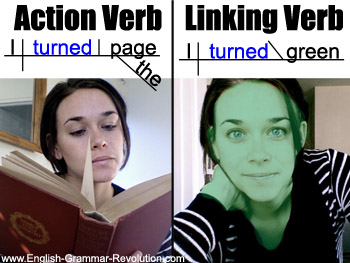|
List of VerbsThis list of verbs should help you to understand verbs a little better. For a more in-depth look at verbs, see the verb page. Quick Refresher: Verbs are words that show action or state of being. There are three main types of verbs: action verbs, linking verbs, and helping verbs (also called auxiliary verbs).  * When you're done with this list of verbs, check out the little lesson in sentence diagramming at the bottom of the page!
|
| clean | cut | drive | eat |
| fly | go | live | make |
| play | read | run | shower |
| sleep | smile | stop | sweep |
| swim | think | throw | trip |
| walk | wash | work | write |
Linking Verbs
These types of verbs link the subject of a sentence with a noun or adjective.
Example:
If you count all of the forms of "to be" as one word, there are 13 linking verbs. Memorize these!
| Forms of be | be, am, is, are, was, were, been, being |
| Other Linking Verbs | appear, become, feel, grow, look, seem, remain, smell, sound, stay, taste, turn |
This video shows you the difference between linking verbs and action verbs. To learn more, see these English grammar lessons.
Helping Verbs
Example: (used with the action verb love)
There are only 24 helping verbs. Use this chart and this lovely song to memorize them!
| be | am | is | are |
| was | were | been | being |
| have | has | had | could |
| should | would | may | might |
| must | shall | can | will |
| do | did | does | having |
How Do You Diagram Verbs?
If you've checked out this site much, you know that I think sentence diagramming rules when it comes to teaching and learning English grammar.
Sentence diagramming is a way to visually show how all of the words in the sentence are related to each other.
All verbs are diagrammed on a horizontal line after the subject.
A vertical line separates the subject from the verb, and the rest of the sentence depends on the type of verb you are diagramming.
Certain action verbs called transitive action verbs transfer action to something called a direct object.

Transitive Passive (A Type of Action Verb)
This type of action verb does not pass any action to anyone or anything.

These verbs link the subject to another noun, pronoun, or adjective.

Helping Verb
Helping verbs help the main verb. They are used in sentences with either linking verbs or action verbs.
It's easy to see that they help another verb when you see how they are diagrammed.

I hope this little diagramming lesson and list of verbs has helped you in your quest for knowledge.
Keep learning. Keep getting smarter!
Read the list of verbs? Click here to learn more about them.
Back to English Grammar Home Page
- Word Lists
- Parts of Speech
- Parts of Speech Quizzes
- Sentence Types
- Verb Tenses
- Phrases
- Clauses
- Parts of Speech Video Lessons
- Sentence Diagramming Exercises
- The Best Grammar Program Ever





